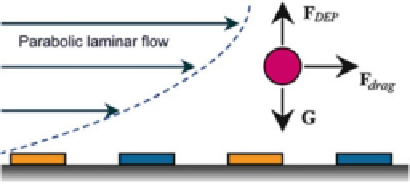Environmental Engineering Reference
In-Depth Information
Fig. 14.8 Diagram showing the principle of a DEP FFF system. Particles are separated in the
vertical direction by a balance of nDEP and gravitational forces. A parabolic fluid flow is applied
and particles are separated
Particles are injected into a carrier flow that passes through the separation chamber,
with a DEP force being applied perpendicular to the flow. The induced flow field has
different velocities at different heights from the bottom surface. Particles are repelled
from the electrodes under nDEP forces. The particles with different dielectrophoretic
properties would have different height therefore move with different velocities. If
another force field is applied vertically (for example, gravitation), the particles will
gather at different places on the lower solid wall. Assuming that the particle is large,
Brownian motion can be neglected, and the levitation height is dictated by the
equilibrium between gravity and the negative DEP force [
11
]:
G
þ
h
F
DEP
i
¼
0
ð
14
:
22
Þ
For a spherical particle of radius
a
, suspended in a fluid medium, the gravitational
force can be calculated as:
g
:
4
3
ˀ
a
3
G ¼
ˁ
p
ˁ
m
ð
14
:
23
Þ
The levitation height for a particle, where gravity balances DEP force, can be
written as [
38
]:
!
K
R
ˁ
p
ˁ
m
g
h
eq
¼
h
0
þ
A
ln
ð
14
:
24
Þ
where
A
and
h
0
are constants depending on the electrode geometry and the applied
electric signal. This key formula expresses the correlation between the levitation
height, the density, and dielectric properties of the particle and of the suspension
medium. Particles that experience different DEP forces will be levitated to different
heights.
The applied velocity field in the channel exerts different hydrodynamic drags on
the nanoparticles that attain different positions away from the chamber wall, which,
in turn, exhibit different characteristic concentration profile. Since different types of
the particles are transported at different rates, a heterogeneous sample can be
separated and fractionated along the channel. The larger particles stay behind and


